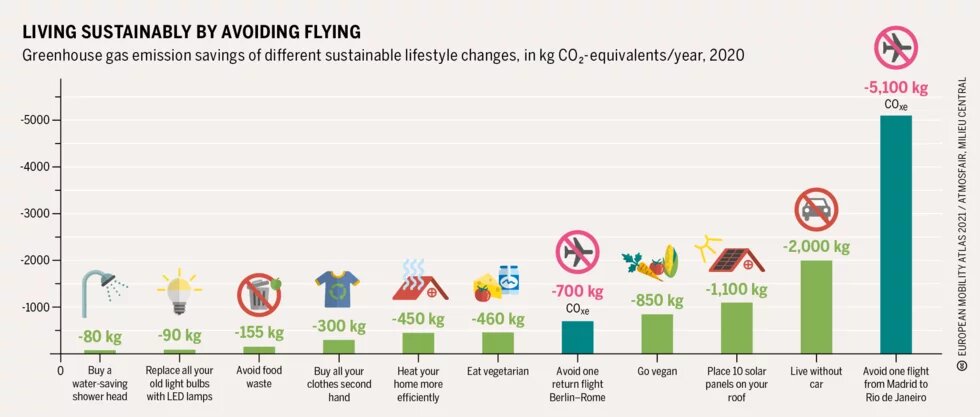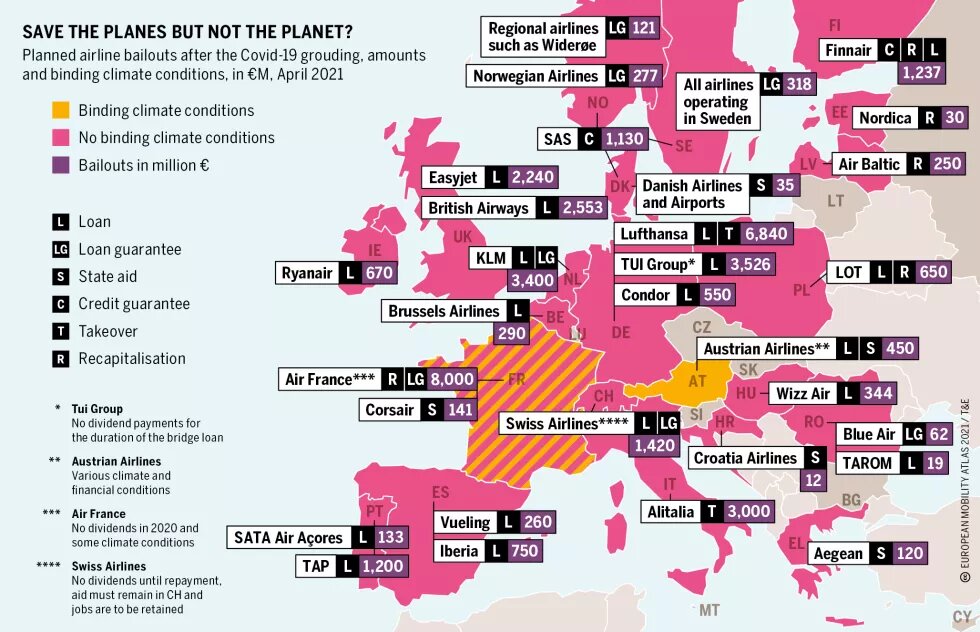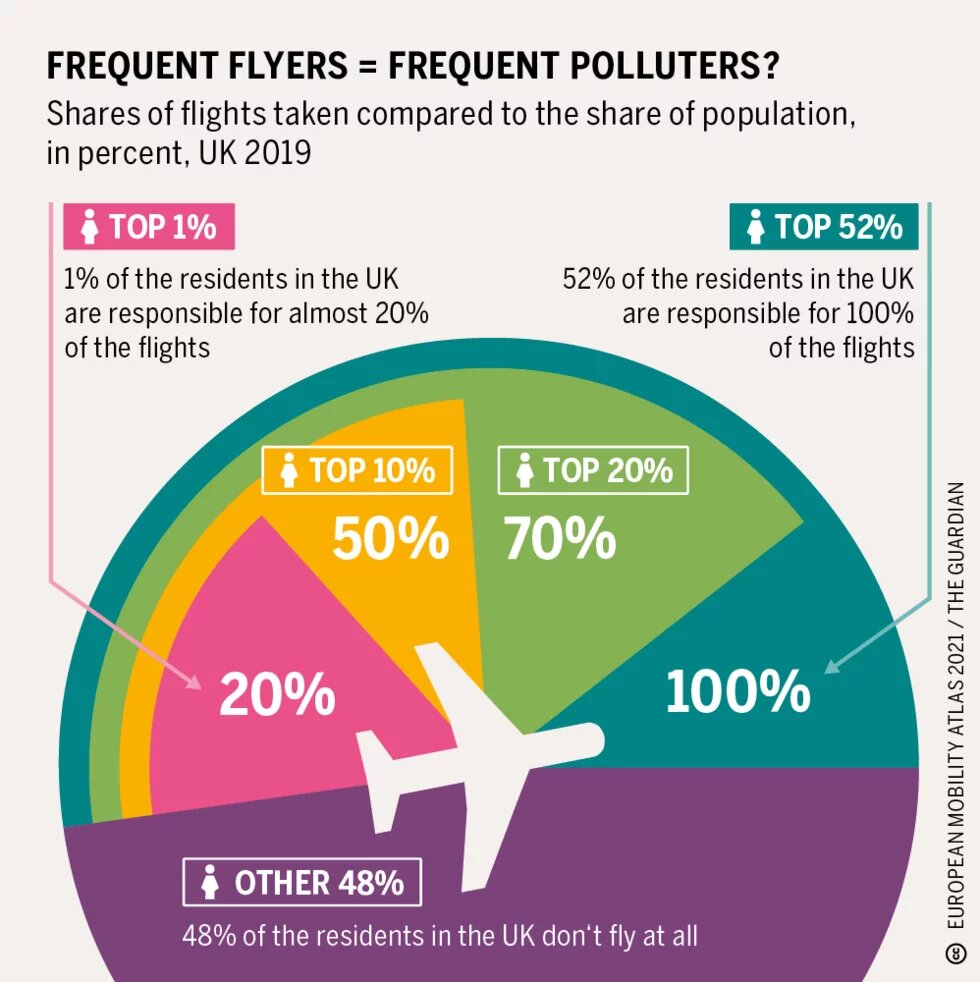
Suddenly, the skies were blue. The Covid-19 lockdown grounded the majority of flights, and analysts say that it could take years for aviation to get back to normal.

The commonplace occurrence of flying is being increasingly questioned for climate reasons: a single long-haul flight generates more emissions than many people around the world produce in a whole year. Aviation is the mode of transport with the biggest climate impact, and who flies and who doesn’t is very unevenly distributed.
According to the industry, aviation accounts for only 2 percent of global CO emissions. However, this omits several key factors. Due to flight emissions taking place at altitude, the overall climate impact of aviation is much stronger than the effect of the CO alone, depending on flight altitude, distance, kerosene and aircraft type. Aviation is therefore estimated to be responsible for 5-8 percent of global climate impact. If unmitigated, aviation emissions are expected at least to double by 2050 and thus consume up to one quarter of the global carbon budget under a 1.5 degree scenario.
Furthermore, compared to other sectors, these emissions are produced by a very small part of the world population: over 80 percent of the global population has never taken a flight. There are various reasons for this: while people with European passports can travel to almost 190 countries without a visa, a Somali or Nepalese citizen, for instance, is allowed to fewer than 40. But it is mostly income disparities that lead to this injustice. In total, the top 10 percent of the global income spectrum uses 75 percent of air transport energy.
In response to growing pressure for climate measures, the UN aviation agency ICAO (International Civil Aviation Organisation) has announced its intention to make international aviation greener in the future. The proclaimed goal is carbon neutral growth from 2020 onwards, defined in the CORSIA programme (Carbon Offsetting and Reduction Scheme for International Aviation). This programme consists of two main elements: modernised and efficient technologies and operations, and carbon offsetting.
By using better technology in new aircrafts, the industry is aiming for fuel efficiency gains of around 1.5 percent. Given that growth rates are estimated at about 4 percent, efficiency savings are overall negligible. Step-changes in aviation technology are uncertain. For example, there is as yet no viable option for electric commercial jets, as batteries simply weigh too much. One proposed solution is therefore to switch fuels: biofuels are on the rise, with palm oil being the cheapest and easiest option. This, however, raises the issue of accelerated deforestation, biodiversity loss and human rights abuses. The other alternative could be synthetic fuel made from electricity. While this is technically feasible, the issue is in the sourcing of the energy: if all planes currently operating were to fly with e-fuels, this would consume more than the existing renewable electricity supply in the world, leaving nothing for other sectors.
As technological solutions are limited, the aviation industry turns instead to emissions offsetting. Such compensation projects are usually located in the global South, involving for example reforestation projects or hydro-electric dams that claim to lead to emissions savings. Offsetting schemes are often criticised for their potential to serve as a cheap licence to continue polluting. Aside from often being subjected to misleading calculations, many offsetting projects lead to side effects including land grabbing and displacement of local communities.
Given that there are no solutions on the horizon to effectively green aviation, climate scientists and growing civil society movements like the global Stay Grounded network point out that the only way to reduce aviation’s emissions is to reduce air traffic. They propose limits for short-haul flights, a moratorium on airport expansion projects and a frequent flyer levy, which would allow a levy-free flight every couple of years, but make every other flight taken more expensive. A key demand is to stop aviation’s regulatory advantages over more sustainable forms of transport and eliminate its tax exemptions: kerosene is the only fossil fuel apart from maritime heavy oil that is not taxed in almost any country and flight tickets are exempt from value-added tax. In the European Union alone, the losses in state revenue due to these aviation subsidies amount to 30 to 40 billion euros annually.
This doesn’t include the billions of euros given to the industry as bailouts due to the Covid-19 crisis: taxpayer-backed money in general without any meaningful environmental or social conditions attached. Securing jobs in these times of crisis has been a key goal for employees, trade unions and NGOs alike – the question is whether and how jobs could be shifted to climate-just sectors such as railway and public transport. This demand for a just transition is gaining more traction now that going back to the normality of flying will take time – the normality for a wealthy world minority, which is increasingly questioned.
Sources for data and graphics: atmosfair gGmbH, https://bit.ly/35LszJy; Milieu Centraal, https://bit.ly/37TdFUi; Transport & Environment, Bailout Tracker, https://bit.ly/2TC02R4; The Guardian, 1% of English residents take one-fifth of overseas flights, survey shows, https://bit.ly/3kKW18U


